Hope is the thing with feathers . . .
It’s a rare Sunday that finds me awake in time to look east for the sun. I’m not normally upright until it’s overhead. But this Sunday is special: I have to get to Brooklyn by 10 am . . . for my first-ever bird-watching experience.
“Really,” you say, “in Brooklyn? Will there be much to see, beside pigeons?” Back in 2012, Heather Wolf wondered the same thing. But lucky for us, she grabbed her binoculars and went birding anyway, in brand-new Brooklyn Bridge Park. There—in what had been a decaying industrial waterfront just two years before—she found mergansers cavorting in the water, gray catbirds scrambling to feed their young, and eventually, with patience, even the rare mourning warbler.
Heather’s finds spurred her on to a Quest: to photograph 100 distinct species in the park. The Quest grew into a book, Birding at the Bridge. And her beautiful book has convinced me to actually get up this morning, to join the Experiment team on a birding tour with Heather as our guide.

Gray catbird, photo © Heather Wolf
Wild goose chase
I have trouble with the subway: The A train is re-routed, so it won’t stop at High Street. I get off at York, but now I need directions. City life! If only I could have gone as the crow flies. Let’s see, here’s the carousel . . . St. Ann’s (a theater) . . . oh, there they are!
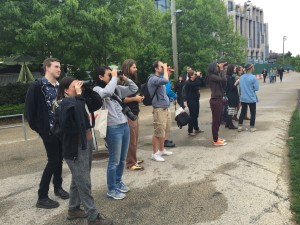
Photo © Ana Ban
I had thought there might be a long wait before someone spotted a bird—but no, everyone is rapt, so I tiptoe up. Vivienne offers me binoculars and points to a somewhat distant tree, where there’s a heron. Wait—a heron?
It’s not a small trick to focus the binoculars on the right cluster of leaves, and I’m nervous I won’t succeed before the heron takes flight. But then there he is—a black-crowned night-heron—poised calmly on a branch that looks not 12 feet off the ground. Jeanne, The Experiment’s birder-in-residence, takes photos through a long lens.
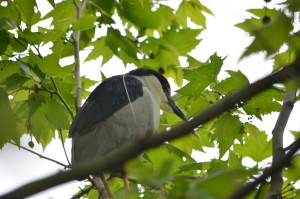
Black-crowned night-heron, photo © Jeanne Tao
I love this heron. He’s big, but looks so light and soft—huggable even. His stern beak is all survival, but that trailing white plume is pure whimsy. I lower the binoculars and he’s tiny once again; I can’t imagine how someone first spotted him from this distance. At the same time, I see another group of park-goers walk practically beneath the heron without noticing. I can imagine myself doing that, all too easily.
A bird’s-eye view
The next two hours change my perspective not just on birds, but on the city. Heather is a detective: To look for birds is to look at your surroundings like a bird—and one micro-climate might be just five paces from the next. Heather has names for them: A slightly muddy clearing is the Magical Knoll. A little grouping of young trees is the Dark Forest.
“It gets darker,” Heather explains, “the leaves are still filling in.”
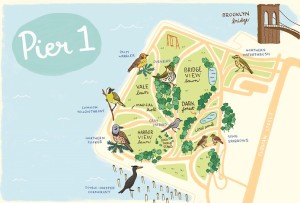
Map © Holly Graham
We traverse the Dark Forest in quiet single file, so we won’t disturb a roosting mother robin. Her nest is right at eye level—a perk, Heather explains, of birding where the trees are young.
At the water’s edge, we meet not only double-crested cormorants, but also darting, swooping barn swallows, with tails that look like crescent moons in flight. “Barn” swallows—in Brooklyn!
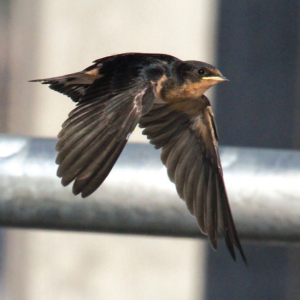
Juvenile barn swallow, photo © Heather Wolf
And then we find a gold mine: A deeper stand of trees slowly reveals an ovenbird, a catbird, an American goldfinch, and more. I’m not birder enough to glimpse them all, but when I finally pick out the finch through binoculars, even in shadow, he’s dazzling.
Ask the most enthusiastic city-dweller you know: Wouldn’t a bit more space be nice, now and then? That’s a sure yes. But without leaving Pier 1, we have just visited five different habitats. I spent ten minutes contentedly scanning a single tree. Birding has made the space around me bigger.
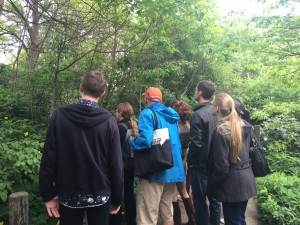
Photo © Ana Ban
Birds of a feather
As we come up against noon, prime birding hours draw to a close—at least until early evening. We circle back to near our starting place, and Heather points out the heron’s tree once again, from a different angle. He’s still there, looking as relaxed as ever—a bird I would have called “exotic,” smack in the middle of a metropolitan park.
“Unless he’s disturbed,” Heather tells us, “he’ll stay there until nightfall. That’s when his day starts.” My kind of bird!
Thank you, Heather, for a wonderful morning in the park. And to my fellow park-goers: Look up!
Links
- Go birding with Heather: Brooklyn Bridge Bird Walks
- Follow Heather on Tumblr: The Birds of Brooklyn Bridge Park
- Come to Heather’s event on June 22 at Brooklyn Brainery
- And preorder Birding at the Bridge, wherever books are sold!



One Response to Brooklyn is for Birders